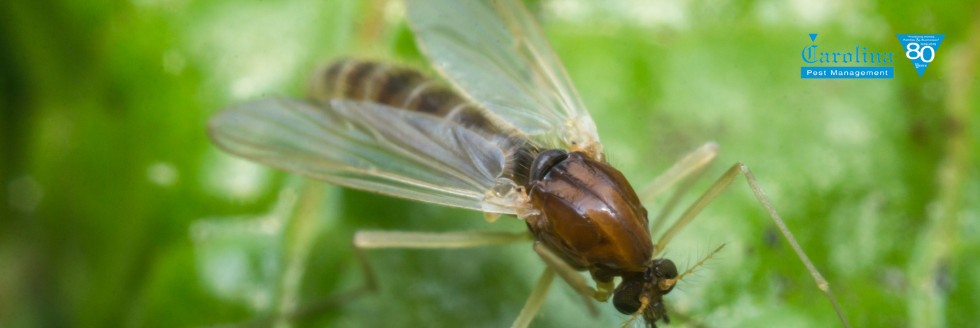Sandfly Pest Control in Charlotte
When it comes to flying, blood-sucking insects, most people think about mosquitoes in Charlotte. But, while mosquitoes are the most problematic, they’re not the only bugs you should be worried about. Another bloodsucker is the sandfly, which can feed on people as well as animals. Although most sandflies stay in the wild, a home infestation can be a huge problem, both as an annoyance and a potential disease vector.

So, with that in mind, let’s learn more about sandflies and what you can do to get rid of them.
What are Sandflies?
The term sandfly (or sand fly) refers to a group of flying insects that feed on blood. These bugs fall into the order Diptera, which also includes regular, non-blood-sucking flies.
As with mosquitoes, sandflies get their nutrients by drawing blood out of a host. Only the females do this, while the males exist to breed and help the females lay eggs. Females can only lay eggs after feeding, though.
Sandflies are much smaller than mosquitoes, so they can be hard to see as individuals. However, these pests do like to swarm, making them much more visible. One common name for sandflies is “no-see-ums” because they’re so tiny. On average, a sandfly is only about three millimeters long, with extended legs and V-shaped wings.
Sandflies have a four-stage lifecycle. First, females will lay up to 70 eggs at a time, which will hatch and turn into larvae. The larvae mature in about three weeks and feed on nutrients in the soil. During the next stage, the larvae turn into pupas and then adults. Overall, it takes sandflies about one to three months to fully mature.
Where Do Sandflies Live?
This pest gets its name because it tends to live in warm, humid environments near sand. So, you’ll find sandflies in tropical locations, such as Florida and other parts of the American South. However, some species of sandfly are only found in Europe and other “old world” countries. Because of this distinction, sandflies are often categorized as “old world” or “new world” varieties.
Since females will lay eggs in moist soil, they tend to stick to areas where water is plentiful (i.e., by creeks and lakes). If they nest inside your home, they’ll breed in wet spots, such as next to a leaky pipe or dripping air conditioner.
What Do Sandflies Eat?
Females will drink blood, while males will subsist on nectar from fruits and flowers. Sandflies are not very picky eaters, meaning that they’ll bite pretty much anything with a pulse, including you and your pets. In the wild, they’ll attack animals like deer, horses, and rodents.
Are Sandflies Dangerous?
They can be, yes. Like mosquitoes, some sandfly species can carry diseases like
- Sandfly fever
- Carrion’s disease
- Pappataci fever
- Vesicular stomatitis virus
These pathogens are somewhat rare, but they can cause complications if they get into your bloodstream. The best way to avoid contracting one of these diseases is to prevent sandfly infestations.
Sandfly bites are also painful and irritating. The pests can leave itchy, red spots all over your skin. Even worse, since the flies usually attack in a swarm, you can wind up with bite clusters that will be even more uncomfortable.
How to Spot a Sandfly Infestation
The only way you can really notice sandflies is when they’re buzzing around and biting you. Female sandflies lay eggs in moist dirt, so it’s almost impossible to tell the location of a breeding site. If you notice flies inside, you likely have a small leak somewhere in the home. If a swarm is outside, pay attention to any water sources like ponds or streams.
Removing and Preventing Sandflies
The best way to prevent sandflies from infesting your home is to keep your house as dry as possible. Pay attention to any drips or leaks as they could attract these and many other pests.
Once an outbreak does occur, it’s virtually impossible to remove sandflies yourself. These pests can breed quickly, and since their nesting sites are so hard to spot, you likely won’t find them before the problem gets out of hand.
Instead, it’s better to call professional pest control experts like Carolina Pest. We have sophisticated tools and extermination techniques that will remove any sandfly infestation from in and around your home. We can also locate potential breeding grounds so that you can keep them clean and dry in the future.
Contact Carolina Pest Today!
Because sandflies are so dangerous, you don’t want to let an infestation get out of hand. Call us immediately once you start to notice these pests, as their populations can swell quickly. We’ll come out and do a full sweep of your home so that we can eradicate these insects for good.
